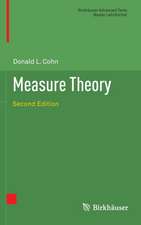Polynomials: Problem Books in Mathematics
Autor Edward J Barbeauen Limba Engleză Paperback – 9 oct 2003
Din seria Problem Books in Mathematics
-
 Preț: 501.78 lei
Preț: 501.78 lei -
 Preț: 403.79 lei
Preț: 403.79 lei - 17%
 Preț: 495.23 lei
Preț: 495.23 lei -
 Preț: 361.55 lei
Preț: 361.55 lei - 20%
 Preț: 692.27 lei
Preț: 692.27 lei - 15%
 Preț: 538.44 lei
Preț: 538.44 lei - 13%
 Preț: 363.89 lei
Preț: 363.89 lei - 17%
 Preț: 433.52 lei
Preț: 433.52 lei - 17%
 Preț: 368.60 lei
Preț: 368.60 lei - 17%
 Preț: 361.89 lei
Preț: 361.89 lei - 15%
 Preț: 362.20 lei
Preț: 362.20 lei - 19%
 Preț: 506.78 lei
Preț: 506.78 lei -
 Preț: 414.42 lei
Preț: 414.42 lei - 15%
 Preț: 651.30 lei
Preț: 651.30 lei -
 Preț: 380.25 lei
Preț: 380.25 lei - 15%
 Preț: 521.09 lei
Preț: 521.09 lei -
 Preț: 447.41 lei
Preț: 447.41 lei - 15%
 Preț: 645.60 lei
Preț: 645.60 lei - 18%
 Preț: 962.81 lei
Preț: 962.81 lei - 15%
 Preț: 478.71 lei
Preț: 478.71 lei - 19%
 Preț: 462.65 lei
Preț: 462.65 lei -
 Preț: 413.37 lei
Preț: 413.37 lei -
 Preț: 458.19 lei
Preț: 458.19 lei - 15%
 Preț: 650.86 lei
Preț: 650.86 lei - 15%
 Preț: 582.12 lei
Preț: 582.12 lei - 15%
 Preț: 580.68 lei
Preț: 580.68 lei - 15%
 Preț: 696.96 lei
Preț: 696.96 lei - 15%
 Preț: 512.67 lei
Preț: 512.67 lei - 15%
 Preț: 536.31 lei
Preț: 536.31 lei -
 Preț: 393.35 lei
Preț: 393.35 lei - 15%
 Preț: 644.63 lei
Preț: 644.63 lei -
 Preț: 386.22 lei
Preț: 386.22 lei - 15%
 Preț: 639.08 lei
Preț: 639.08 lei - 15%
 Preț: 674.42 lei
Preț: 674.42 lei - 15%
 Preț: 476.45 lei
Preț: 476.45 lei - 15%
 Preț: 487.55 lei
Preț: 487.55 lei - 15%
 Preț: 651.02 lei
Preț: 651.02 lei -
 Preț: 345.06 lei
Preț: 345.06 lei -
 Preț: 384.86 lei
Preț: 384.86 lei -
 Preț: 379.86 lei
Preț: 379.86 lei -
 Preț: 965.95 lei
Preț: 965.95 lei
Preț: 706.16 lei
Preț vechi: 830.77 lei
-15% Nou
Puncte Express: 1059
Preț estimativ în valută:
135.12€ • 141.08$ • 111.83£
135.12€ • 141.08$ • 111.83£
Carte tipărită la comandă
Livrare economică 05-19 aprilie
Preluare comenzi: 021 569.72.76
Specificații
ISBN-13: 9780387406275
ISBN-10: 0387406271
Pagini: 455
Ilustrații: XXII, 455 p.
Dimensiuni: 155 x 235 x 26 mm
Greutate: 0.68 kg
Ediția:1st ed. 1989. 3rd printing 2003
Editura: Springer
Colecția Springer
Seria Problem Books in Mathematics
Locul publicării:New York, NY, United States
ISBN-10: 0387406271
Pagini: 455
Ilustrații: XXII, 455 p.
Dimensiuni: 155 x 235 x 26 mm
Greutate: 0.68 kg
Ediția:1st ed. 1989. 3rd printing 2003
Editura: Springer
Colecția Springer
Seria Problem Books in Mathematics
Locul publicării:New York, NY, United States
Public țintă
ResearchCuprins
1 Fundamentals.- 1.1 The Anatomy of a Polynomial of a Single Variable.- 1.2 Quadratic Polynomials.- 1.3 Complex Numbers.- 1.4 Equations of Low Degree.- 1.5 Polynomials of Several Variables.- 1.6 Basic Number Theory and Modular Arithmetic.- 1.7 Rings and Fields.- 1.8 Problems on Quadratics.- 1.9 Other Problems.- Hints.- 2 Evaluation, Division, and Expansion.- 2.1 Horner’s Method.- 2.2 Division of Polynomials.- 2.3 The Derivative.- 2.4 Graphing Polynomials.- 2.5 Problems.- Hints.- 3 Factors and Zeros.- 3.1 Irreducible Polynomials.- 3.2 Strategies for Factoring Polynomials over Z.- 3.3 Finding Integer and Rational Roots: Newton’s Method of Divisors.- 3.4 Locating Integer Roots: Modular Arithmetic.- 3.5 Roots of Unity.- 3.6 Rational Functions.- 3.7 Problems on Factorization.- 3.8 Other Problems.- Hints.- 4 Equations.- 4.1 Simultaneous Equations in Two or Three Unknowns.- 4.2 Surd Equations.- 4.3 Solving Special Polynomial Equations.- 4.4 The Fundamental Theorem of Algebra: Intersecting Curves.- 4.5 The Fundamental Theorem: Functions of a Complex Variable.- 4.6 Consequences of the Fundamental Theorem.- 4.7 Problems on Equations in One Variable.- 4.8 Problems on Systems of Equations.- 4.9 Other Problems.- Hints.- 5 Approximation and Location of Zeros.- 5.1 Approximation of Roots.- 5.2 Tests for Real Zeros.- 5.3 Location of Complex Roots.- 5.4 Problems.- Hints.- 6 Symmetric Functions of the Zeros.- 6.1 Interpreting the Coefficients of a Polynomial.- 6.2 The Discriminant.- 6.3 Sums of the Powers of the Roots.- 6.4 Problems.- Hints.- 7 Approximations and Inequalities.- 7.1 Interpolation and Extrapolation.- 7.2 Approximation on an Interval.- 7.3 Inequalities.- 7.4 Problems on Inequalities.- 7.5 Other Problems.- Hints.- 8 Miscellaneous Problems.- E.62 Zeros of z?1[(1 + z)n ? 1 ? zn].- E.63 Two trigonometric products.- E.64 Polynomials all of whose derivatives have integer zeros.- E.65 Polynomials with equally spaced zeros.- E.66 Composition of polynomials of several variables.- E.67 The Mandelbrot set.- E.68 Sums of two squares.- E.69 Quaternions.- Hint.- Answers to Exercises and Solutions to Problems.- Notes on Explorations.- Further Reading.
Recenzii
From the reviews:
E.J. Barbeau
Polynomials
"This book uses the medium of problems to enable us, the readers, to educate ourselves in matters polynomial. In each section we are led, after a brief introduction, into a sequence of problems on a certain topic. If we do these successfully, we find that we have mastered the basics of the topic. If we have any difficulties, we can refer first to the hints, and, failing these, to the detailed solutions. These form an important and substantial part of the book, and often refer the reader on to the research literature. The book, like good literature, can be read successfully at different levels, and would not be out of place in any mathematician's library."—MATHEMATICAL REVIEWS
“This is a two-faced book, and that’s a good thing. One face is a set of enrichment materials for bright high school students. The other face is a fairly comprehensive textbook on algebraic properties of polynomials. … The present book is an excellent introduction to the subject for anyone, from high schooler to professional.” (Allen Stenger, The Mathematical Association of America, August, 2011)
E.J. Barbeau
Polynomials
"This book uses the medium of problems to enable us, the readers, to educate ourselves in matters polynomial. In each section we are led, after a brief introduction, into a sequence of problems on a certain topic. If we do these successfully, we find that we have mastered the basics of the topic. If we have any difficulties, we can refer first to the hints, and, failing these, to the detailed solutions. These form an important and substantial part of the book, and often refer the reader on to the research literature. The book, like good literature, can be read successfully at different levels, and would not be out of place in any mathematician's library."—MATHEMATICAL REVIEWS
“This is a two-faced book, and that’s a good thing. One face is a set of enrichment materials for bright high school students. The other face is a fairly comprehensive textbook on algebraic properties of polynomials. … The present book is an excellent introduction to the subject for anyone, from high schooler to professional.” (Allen Stenger, The Mathematical Association of America, August, 2011)










